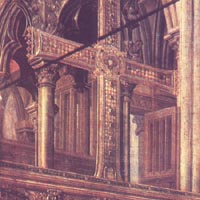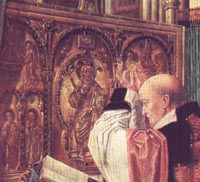
Abbot Suger should play a central role in any course on medieval art. As the Abbot of the French Royal Abbey of St. Denis, north of Paris, Suger was responsible for the redesign of the west facade and the east end of the church. We will examine these additions to St. Denis later in the course in the context of the beginnings of Gothic architecture. Suger also left us two texts pertaining to his contributions to St. Denis: De Administratione and De Consecratione. Suger's discussions of his additions are relevant to our discussion of the art of the medieval church treasury. Compare the following description of the Golden Crucifix to the poem, The Dream of the Rood. Alison Stones presents an excellent overview of the treasury of St. Denis.

We should have insisted with all the devotion
of our mind --had we but had the power-- that the adorable, life-giving
cross, the health-bringing banner of the eternal victory of Our
Saviour (of which the Apostle says: "But God forbid that
I should glory, save in the cross of our Lord Jesus Christ [Galatians
6:14]"), should be adorned all the more gloriously as the
sign of the Son of Man, appearing in the sky at the utmost danger,
is glorious not only to men but also to the very angels; and we
should have perpetually greeted it with the Apostle Andrew: "Hail
Cross, which art dedicated in the body of Christ and adorned with
His members even as with pearls." But since we could not
do as we wished, we wished to do as best we could, and strove
to bring it about by the grace of God. Therefore we searched around
everywhere by ourselves and by our agents for an abundance of
precious pearls and gems, preparing as precious a supply of gold
and gems for so important an embellishment as we could find, and
convoked the most experienced artists from diverse parts. They
would with diligent and patient labor glorify the venerable cross
on its reverse side by the admirable beauty of those gems; and
on its front --that is to say in the sight of the sacrificing
priest-- they would show the adorable image of our Lord the Savior,
suffering, as it were, even now in remembrance of His Passion....
We applied to the perfection of so sacred an ornament not only
these but also a great and expensive supply of other gems and
large pearls. We remember, if memory serves, to have put in about
eighty marks of refined gold. And barely within two years were
we able to have completed, through several goldsmiths from Lorraine
-- at times five, at other times seven-- the pedestal adorned
with the Four Evangelists; and the pillar upon which the sacred
image stands, enameled with exquisite workmanship, and [on it]
the history of the Savior, with the testimonies of the allegories
from the Old Testament indicated, and the capital above looking
up, with its images, to the Death of the Lord. Hastening to honor
and extol even more highly the embellishment of so important and
sacred a liturgical object, the mercy of our Savior brought to
us our Lord Pope Eugenius for the celebration of holy Easter (as
is the custom of Roman Pontiffs, when sojourning in Gaul, in honor
of the sacred apostolate of the blessed Denis, which we have also
experienced with his predecessors, Callixtus and Innocent); and
he solemnly consecrated the aforesaid crucifix on that day. Out
of the title "The True Cross of the Lord Surpassing All and
Every Pearl" he assigned to it a portion fro his chapel;
and publicly, in the presence of all, he anathematized, by the
sword of the blessed Peter and by the sword of the Holy Ghost,
whosoever would raise his hand against it in reckless temerity;
and we ordered this ban to be inscribed at the foot of the cross.

We hastened to adorn the Main Altar of the blessed Denis where there was only one beautiful and precious frontal panel from Charles the Bald, the third Emperor; for at this [altar] we had been offered to the monastic life. We had it all encased, putting up golden panels on either side and adding a fourth, even more precious one; so that the whole altar would appear golden all the way round. On either side, we installed there the two candlesticks of King Louis, the son of Philip, of twenty marks of gold, lest they might be stolen on some occasion; we added hyacinths, emeralds, and sundry precious gems; and we gave orders carefully to look out for others to be added further. The verses on these [panels] are these.
On the right side:
' Abbot Suger has set up these altar panels
In addition to that which King Charles has given before.
Make worthy the unworthy through thy indulgence, O Virgin Mary
May the fountain of mercy cleanse the sins both of the King
and the Abbot.'
On the left side:
"If an impious person should despoil this excellent altar
May he perish, deservedly damned, associated with Judas."
But the rear panel, of marvelous workmanship
and lavish sumptousness (for the barbarian artists were even more
lavish than ours), we ennobled with chased relief work equally
admirable for its form as for its material, so that certain people
might be able to say: "The workmanship surpassed the material."
Much of what had been acquired and more of such ornaments of the
church as were afraid of losing --for instance, a golden chalice
that was curtailed of its foot and several other things-- we ordered
to be fastened there. And because the diversity of the materials
[such as] gold, gems, and pearls is not easily understood by the
mute perception of sight without a description, we have seen to
it that this work, which is intelligible only to the literate,
which shines with the radiance of delighted allegories, be set
down in writing. Also we have affixed verses expounding the matter
so that the [allegories] might be more clearly understood:
"Crying out with a loud voice, the mob acclaims Christ: 'Osanna.'
The true Victim offered at the Lord's Supper has carried all men.
He Who saves all men on the Cross hastens to carry the cross.
The promise which Abraham obtains for his seed is sealed by the
flesh of Christ, Melchizedek offers a libation because Abraham
triumphs over the enemy.
They who seek Christ with the Cross bear the cluster of grapes
upon a staff.
Often we contemplate, out of sheer affection for the church our mother, these different ornaments both new and old; and when we behold how that wonderful cross of St. Eloy --together with the smaller ones--- and that incomparable ornament commonly called the 'Crest' are placed upon the golden altar, then I say sighing deeply in my heart: "Every precious stone was thy covering, the sardius, the topaz, and the jasper, the chrysolite, and the emerald [Exekiel 28:13]." To those who know the properties of precious stones it becomes evident, to their utter astonishment, that none is absent from the number of these (with the only exception of the carbuncle), but that they abound most copiously. Thus, when --out of my delight in the beauty of the house of God-- the loveliness of the many-colored gems has called me away from external cares, and worthy meditation has induced me to reflect, transferring that which is material to that which is immaterial, on the diversity of the sacred virtues: then it seems to me that I see myself dwelling, as it were, in some strange region of the universe which neither exists entirely in the slime of the earth nor entirely in the purity of Heaven; and that, by the grace of God, I can be transported from this inferior to that higher world in an anagogical manner.